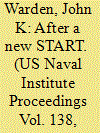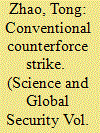| Srl | Item |
| 1 |
ID:
130323


|
|
|
| 2 |
ID:
121225


|
|
|
|
|
| Publication |
2012.
|
| Summary/Abstract |
Canada proved to be a reliable and cooperative partner of the Americans
on a variety of air defence initiatives in the early Cold War. Both countries
constructed a dense network of radar lines, prioritized their respective air
defence forces, and eventually agreed to a binational North American Air
Defence Command (NORAD), imbued with the operational control of both
countries' air defence forces. However, Canada's role in strategic defence
was just as quickly challenged by the development of intercontinental
ballistic missiles. NORAD's raison d'être shifted to the early warning and
tracking of these long-range delivery systems, even as Washington became
increasingly infatuated with the potential of missile defences from the late
1960s onward. Importantly, Canada consistently refrained from cooperating
with the United States on strategic missile defence.
|
|
|
|
|
|
|
|
|
|
|
|
|
|
|
|
| 3 |
ID:
108152


|
|
|
|
|
| Publication |
2011.
|
| Summary/Abstract |
China and some other nuclear-armed countries have become concerned about the development and deployment of U.S. conventional global strike systems that may permit damage limitation operations against the nuclear forces of adversaries. This article argues that a counterforce strike is more likely to target tactical nuclear forces than intercontinental ballistic missiles and provides an analysis of the probability that U.S. conventional strikes might destroy China's theater nuclear forces which include DF-3A, DF-4, DF-21, DF-31 missiles, Type 094 nuclear submarines, and nuclear-capable H-6 bombers. The results indicate that China's strategy of building robust underground facilities may effectively protect its nuclear forces from preemptive strikes making it unlikely that a U.S. conventional strike could destroy a meaningful part of China's theater nuclear forces. This study also assesses the potential capabilities of future conventional prompt global strike systems, points out problems with the strategy of damage limitation, and proposes that the United States consider improving strategic stability in its relationship with China rather than threatening a preemptive strike.
|
|
|
|
|
|
|
|
|
|
|
|
|
|
|
|
| 4 |
ID:
054563


|
|
|
|
|
| Publication |
New York, American Institute of Physics, 1989.
|
| Description |
xxiii, 287p.
|
| Standard Number |
0883186160
|
|
|
|
|
|
|
|
|
|
|
|
Copies: C:1/I:0,R:0,Q:0
Circulation
| Accession# | Call# | Current Location | Status | Policy | Location |
| 030861 | 358.1754/LEV 030861 | Main | On Shelf | General | |
|
|
|
|
| 5 |
ID:
096981


|
|
|
| 6 |
ID:
106333


|
|
|
|
|
| Publication |
2011.
|
| Summary/Abstract |
The survivability of China's ballistic missile submarines and submarine-launched ballistic missiles is examined. First, the Type 094 ballistic missile submarine is noisy and vulnerable even in shallow waters. This suggests the urgency for China to improve the quietness of the Type 094. Second, after the deployment of the U.S. interceptor missile, SM-3 Block IIA, in 2018, China's intercontinental ballistic missiles and submarine-launched ballistic missiles launched from Chinese coastal waters would face a three-layer engagement, constructed by SM-3 IIAs deployed near China's coastal waters, ground-based interceptors deployed in California and Alaska, and SM-3 IIAs deployed near U.S. coastal waters respectively. These deployments could undermine the credibility of China's nuclear deterrence. It would be well for China and the United States to work together to improve strategic stability between these two states.
|
|
|
|
|
|
|
|
|
|
|
|
|
|
|
|